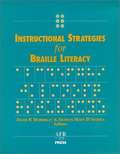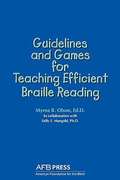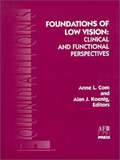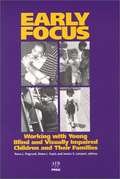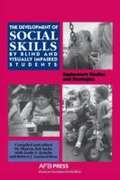Special Collections
American Foundation for the Blind
Description: American Foundation for the BlindPress offers a wide range of information for students, professionals, researchers, and blind and visually impaired people and their families. #teachers #disability
- Table View
- List View
Non-Sighted and Sighted Adults' Volumetric Perceptions of Functional Objects
by T. M. Nelson and C. J. Ladan and J. EppsA report on the study of the manner in which sighted, sighted-but-blindfolded, late-blind (subsequent to 7 years of age), and congenitally blind (blind since birth) persons employ physical parameters in determining weight and volume of functional objects.
Manual for the Stanford Multi Modality Imagery Test
by William L. DautermanThe author's data on the test called "The Stanford Multi-Modality Imagery Test for the Blind" as a part of a research project has been revised in this manual under the name of "The Stanford Multi-Modality Imagery Test."
Mainstreaming and the American Dream
by Howard Nixon IIBased on in-depth interviews with parents and professionals, this research monograph presents a sociological framework for looking at the needs and aspirations of parents of blind and visually impaired children.
Low Vision
by Virginia E. Bishop and Jane N. Erin and Anne CornThis research report, based on a multiphase survey of professionals, identifies important trends into the next century. Designed for administrators, policy planners and university instructors, as well as for direct service providers, Low Vision includes background overview papers by six eminent leaders in the low vision field.
Looking at Employment Through a Lifespan Telescope
by Corinne Kirchner and Emilie Schmeidler and Alexander TodorovThis book gathers representative survey data from the legally blind population on employment issues, and analyzes it using a lifespan perspective (considering age, career stage, and age-at-onset of visual impairment), which is critical to understanding widely different employment issues for subgroups of the blind and visually impaired population.
Living with Impaired Vision
by Anne Yeadon and Dava GraysonBlind and visually impaired people: active, concerned about their jobs, their families, their communities, obtaining a good education, discovering interesting ways to use their leisure time, and above all, as different from one another as any other group of people who happen to have one characteristic in common. Today there are visually impaired people in every major area of employment from professional occupations to technical and clerical work. There are blind lawyers and college professors and insurance salesmen and social workers, blind typists and switchboard operators, auto mechanics and chemical engineers.
An Introduction to Working with the Aging Person Who Is Visually Handicapped (2nd edition)
by Dava GraysonThis book deals with aged blind persons, the ways and means of lending them a helping hand, services available to them, and solving other problems.
Instructional Strategies for Braille Literacy
by Diane P. Wormsley and Frances M. D'AndreaOffers instructors specific, practical strategies for the teaching of Braille reading and writing. Chapters discuss general guidelines and strategies; fostering emergent learning; making the transition from print to Brail teaching Braille to students with special needs, and to students who speak English as a second langua assessing the literary skills of students who are blind or visually impaired; and technology and Braille. Annotation copyrighted by Book News, Inc. , Portland, OR
The Influence of Parental Attitudes and Social Environment on the Personality Development of the Adolescent Blind
by Vita Stein SommersThe author's experience with visually handicapped children and young adults in schools is richly used in this study of the influence Of parental attitudes and social environment on the personality development of the adolescent blind.
Images of Blind and Visually Impaired People in the Movies, 1913-1985
by Wendy Erickson and Diane WolfeListed in this book are the titles and other information about movies that include characters who are blind or visually impaired.
HIV/AIDS Prevention
by Judy Matsuoka and Christine E. Pawelski. and Gaylen KappermanThis manual is designed to help rehabilitation teachers, educators, and other practitioners who work with blind and visually impaired persons provide their clients with the facts they need to deal with the issues concerning HIV/AIDS.
Hand in Hand
by Elga Joffee and Jeanne Glidden Prickett and Therese Rafalowski Welch and Kathleen Mary HuebnerThis series was designed to develop resources for educators of children who are visually impaired, hearing impaired, and severely disabled. The Hand In Hand materials emphasize the communication and mobility skills crucial to independence, and provide important information to help service providers do their jobs effectively. Containing contributions from more than 30 nationally recognized experts in the field of deaf-blindness, this groundbreaking information consists of four components that can be used separately or together. A two-volume, self-study text that explains how deaf-blind students learn, focusing on essential communication and mobility skills. Designed to provide comprehensive information in an easy-to-read way, this invaluable resource includes identified key concepts, self-study questions and answers, and references. The user-friendly format includes concise "Help at a Glance" and "From Theory to Practice" sections throughout. Sidebars, figures, tables, graphs, and photos offer additional perspectives and information.
Guidelines and Games for Teaching Efficient Braille Reading
by Myrna R. Olson and Sally S. MangoldThese unique guidelines and games provide ideas for adapting a general reading program to the needs of braille readers and enriching early instruction in braille that are based on research in the areas of rapid reading and precision teaching. Classroom teachers and anyone working with children who are blind or visually impaired will find this classic handbook an invaluable resource.
The Future of Work for Disabled People
by Ian Morris and Wassily Leontief and Walter Y. Oi and William F. Gallagher and Curt Tausky and Timm Kainen and Lawrence A. Scadden and William J. Dennis and Dennis Chamot and Jesse M. Smith and Erich Bloch and Joseph F. CoatesThis important book, by an impressive and talented team of authors, will help us plan to ensure that workers with disabilities find their rightful place in the workplace of the future.
From Homer to Helen Keller
by Richard Slayton FrenchFrom Homer to Helen Keller, Homer stands for the greatest achievement of the blind in the times antecedent to their systematic education. He stands for all those bards, many of them blind or blinded, creators of literature and makers of our language, who through ballads, always of great vigor and sometimes of surpassing beauty, have handed down to us the glorious traditions of far-off heroic times.
Miss Keller stands for the supreme achievement of education. The blind claim her, but the deaf can claim her, too, and modern education can claim her more than either--and all humanity claims her with the best claim of all. For she is the epitome of all that is best in humanity, all that is most spiritual; and all this through conscious aim and directed effort, through education in its best sense.
Foundations of Low Vision
by Alan J. Koenig and Anne L. CornThis text explains in great detail how to do low vision exams, the principles behind magnifiers and other forms of magnification, and much more.
Essays on Blindness Rehabilitation in Honor of Thomas J. Carroll
by John F. MuldoonThe author of the articles in this book has given us an excellent assessment of Father Carroll's concepts and the viability of those concepts today. Moreover, they have provided us with a look at the man behind the ideas.
English / Spanish Basics for Orientation and Mobility Instructors
by Christian J. FoyThis book was written as a teaching aid for orientation and mobility (O&M) instructors. Author's intention is not to teach the techniques of the profession but to supply the vocabulary instructors might use to teach students in Spanish.
The Effects of Blindness and Other Impairments on Early Development
by Zofja S. JastrazembskaA scientific study of blind children, where there are frequently marked delays in locomotor achievements by sighted standards.
Early Focus
by Jessica S. Lambert and Diane L. Fazzi and Rona L. PogrundStressing the importance of early intervention in working with children with visual impairment, Pogrund (formerly special education, California State U.) and Fazzi (special education, California State U.) offer practitioners (teachers and other specialized professionals) an edited guide to working with children under age five. Eleven chapters review the developmental areas that are likely to be affected by vision loss and discuss the theory and knowledge base behind suggested educational practices in these areas. Chapters cover working with families, medical and functional implications, cognitive development, literacy, social development, promotion of independence and daily living skills, behavioral supports, motor and mobility development, and working with other professionals. Annotation (c)2003 Book News, Inc., Portland, OR (booknews.com)
Diabetes, Vision Impairment, and Blindness
by Allene R. Van SonVision impairment is a common complication of diabetes mellitus, which is itself the leading cause of new cases of blindness among adults in the United States. Three percent of the country's 10 million diabetics have experienced severe vision loss as a result of the disease. This means that diabetics frequently have to face additional problems of impending loss of vision and blindness. The purpose of this pamphlet is to explain the relationship between visual impairment and diabetes and to identify recent advances in treatment and rehabilitation to help diabetics and their families deal with the problems of vision loss.
The Development of Social Skills by Blind and Visually Impaired Students
by Sharon Zell Sacks and Linda S. Kekelis and Robert J. Gaylord-RossThe book, using an ethnographic approach, outlines the theoretical background of social-skills development, presents case studies and suggests guidelines for helping Blind and Visually Impaired children shape those encounters into satisfying ones.
The Demography of Blindness Throughout the World
by Hyman GoldsteinMost of the world's blindness could be prevented, and the attack on it and its consequences proceeds apace through such organizations as the World Council for the Welfare of the Blind, the International Agency for the Prevention of Blindness, and the World Health Organization.
For greatest effectiveness, their programs must be based upon accurate data, as a WHO study quoted here by Dr. Goldstein makes clear: "In order to establish appropriate priorities for prevention and treatment at the national and international level, it is essential that reliable up-to-date statistical data on prevalence, age of onset, and causes of blindness be obtained."
But even in the United States, where collection of data on blindness began in 1830, there are still no reliable trend data. In much of the rest of the world data are fragmentary, and data that would allow valid country by country comparisons are almost non-existent.
Dr. Goldstein has done a valuable service in pulling together such statistics as can be found, and in discussing their weaknesses and strengths.
The Demography and Causes of Blindness
by Hyman GoldsteinA report on the statistics of blindness from an international point of view.
Data on Blindness and Visual Impairment in the U. S.
by Corinne KirchnerData from a wide variety of sources cover age, gender, race and ethnicity, education, employment and income, service delivery systems, vision services, employment-related services, and income benefits program.

